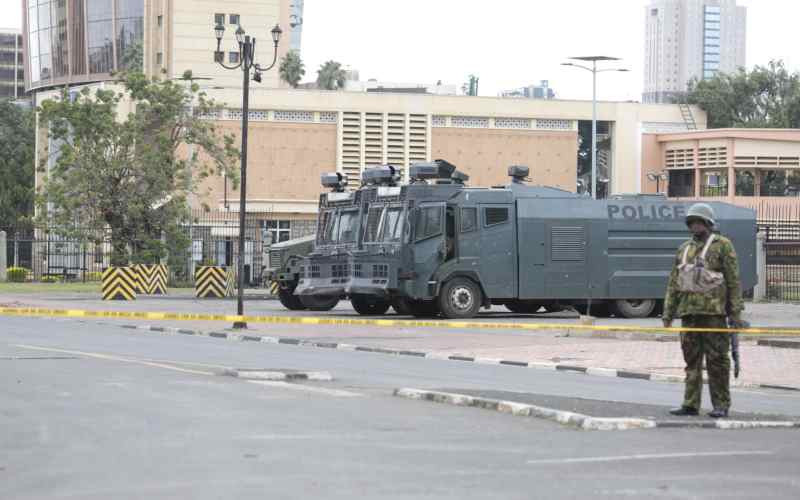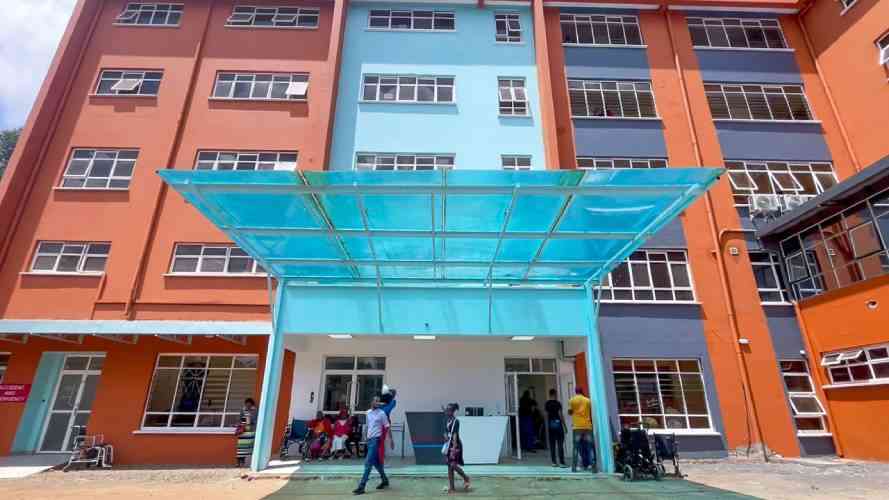
Samira Mwende and her little daughter Faiza nearly became part of these dispiriting statistics were it not for a surgeon and a nursing team at Kibwezi Sub County Hospital in Makueni County.
Mwende, already a mother of another child, went into labour and was rushed to the health facility.
After a Caesarean section operation, she started bleeding profusely, and uncontrollably. As life ebbed away from her, she could only remember how one nurse, Daniel Muoka, was covering her as he struggled to resuscitate her.
“I could hear echoes of the team talking, but I was not there, really; I was going, and I remember his voice calling and not giving up on me,” Samira says.
Samira was experiencing postpartum haemorrhage (PPH), one of the deadliest complications after childbirth.
As nurse Daniel Muoka and the surgical team in Kibwezi watched Samira’s condition worsen, they knew the mother needed a more experienced surgeon to identify where the bleeding was coming from.
However, the team realised that the mother, who was then unconscious, had less than half an hour to live.
“She or the baby would have died had we referred her,” nurse Daniel Muoka said.
- Trans Nzoia county receives Sh2 million maternity beds, mattresses donation
- Counties urged to adopt AI to reduce maternal deaths
- Mothers' stories of hope in the face of maternal health risks
- Jacaranda Health banks on AI-driven initiatives to support maternal healthcare
Keep Reading
Instead, the team called Dr Joseph Gatura, an experienced surgeon at Makindu Hospital.
At 3 am, Dr Gatura drove to Kibwezi Sub County Hospital. In a short while, the surgeon identified challenges that only a surgeon would have noticed, such as the placenta crossing past the wall of the uterus, and extending to part of the bladder. When the placenta does not come out as was in Samira’s case, the uterus does not contract, hence the bleeding continues.
“She had very little time; she would not have survived longer than half an hour,” Dr Gatura tells The Standard.
Being an expansive county, many mothers like Samira die due to the time wasted during referral from one facility to another whenever there is a complication.
A 2018 study published in the journal, Nature, implicated PPH in most of the cases of women who missed death by a whisker during delivery in Kenya and those who never survived it.
According to Osborn Koech, a midwife and maternal and health specialist at the John Hopkins Affiliate Jhpiego, multiple reasons cause PPH but the most common is due to the failure of the uterus to contract adequately after childbirth.
Makueni County’s strategy has been to ensure that women get professional medical attention in the shortest time possible.
Working with a project called Antenatal and Postnatal Care Research Collective (ARC) in 2022, the county instituted the Networks of Care in 60 health facilities for the pilot.
“We mapped all the resources in the county from hospitals to surgeons, to blood banks, ambulances and knew where they were in the county; then we linked the nearest higher level facility to a lower one, and put that poster at each facility with a phone number of who they should call,”, says Acting Director of Health Services for Makueni, Dr Stephen Mwatha.
“The county then gathered all the healthcare workers to agree on the information that should be collected when a patient is referred or monitored so that when another team takes over they know what has been done; using this information, we made specialised forms that healthcare workers fill,” he adds.
Loise Nzilani, the head nurse of the Mother Child unit of the Makueni County Referral Hospital says she noticed a huge difference in the way the nurses from the lower-level facilities handle children before they reached her.
“I had lost count of the number of newborns we lost on their way here due to simple things like they were not warm enough; this has changed because the nurses call us before they refer and with it, they bring us a detailed referral that tells us here all the medical information we need to take care of these very sick children fast,” she says.
However, this success in Makueni is not an act out of the norm.
According to Maternal and Child Health Journal, a similar endeavour yielded confounding, yet sweet results in the West African state of Nigeria, where an evaluation of the Networks of Care of 18 months of use reduced maternal mortality by more than 37%. This nearly halved the deaths of children under one month, where stillbirths were 18% lower.
Had everything been done as is normal in the county hospital, operating on Samira and then referring her to a specialised facility when she experienced bleeding, would have costed her life and that of her daughter.
“I do not have anything to give to the team that looked after me; only God can pay them,” Samira tells ‘The Standard.’
Once a “Dark spot” hospital, Kibwezi Subcounty Hospital now records 0 maternal deaths
|A few years back, Kibwezi Sub-county Hospital, a health facility that performs as many as 600 caesarean operations in a month, had a label of “the dark spot”. Mothers and new-borns died in numbers whenever they developed any complications, some of which could be mitigated, and managed.
However, in the last two years, the hospital has not recorded a maternal death, moving from as many as 4 to none per year. The hospital also experienced the greatest reduction in perinatal mortality (the deaths of children a week after they are born) from 398 to 251. Neonatal mortality, the death of babies if it occurs 28 days after birth, is reduced by more than 400% from 26 to 5.
At its location, Kibwezi Subcounty Hospital is on the periphery of the county and is the only Comprehensive Emergency Obstetric and Newborn Care (CEmONC)facility. This is because, on top of other services needed to save a mother, the facility also offers Caesarean section operation.Patricia Musau, the Nurse-midwife and manager at the facility, says they often receive severely ill mothers and babies in critical condition from very far to the hospital.“We receive all sorts of cases, excessive bleeding, ruptured uterus, and all sorts of obstetric emergencies,” Patricia reveals.
As a CEmONC facility, Patricia and the team can often handle some of the cases that land at their door.
Others may need surgical care too advanced the hospital is not equipped to handle. In the process of referral to the county’s largest facility in Wote - Makueni County Referral Hospital - the mothers often do not endure the two-and-a-half-hour drive.
“The time in referral, such as delay in the patient being brought here, and then when they are here prepping the ambulance which may have even rushed another patient for care, or we have run out of blood… these delays can be the undoing of the mothers and their babies who do not have time,” Patricia says.
Death during referrals for mothers is a common public health challenge in Kenya. A 2022 study in the journal BMC Pregnancy and Childbirth, which investigated the deaths of patients in Migori, attributed these deaths to delays that cause the death of anyone seeking emergency care.
“Delays in the community or the patient deciding to go to the hospital, delays caused by infrastructure like roads, and delays in receiving quality care in poorly staffed and equipped health facility,” part of the report says.
Like most public health facilities, Kibwezi experiences stockouts of life-saving commodities like blood from the patients they receive.
The ambulances are also few, to cater for a huge population. As the facility’s management team and the county’s health department stared at the ghastly statistics of death, the county needed solutions fast.
Working with a research project from the John Hopkins Affiliate, Jhpiego, the Antenatal and Postnatal Care Research Collective (ARC), Makueni County mapped what resources they had nearer Kibwezi.
“One time I had a mother here who needed blood urgently, and we knew she would need intensive care later; we called Kilungu who put the blood in their ambulance and brought it to us, and Dua Hospital which is a private hospital sent their ambulance and emergency team to take the mother to Makueni County Referral,” Patricia says.
Dr Stephen Ndolo, Makueni County’s Chief Office of Health said that the documents are one of the county’s ways to ensure that referral is not shifting burden to another health facility but a continuation of care.
The Ministry of Health’s 2017 investigation into what kills mothers revealed that 50% of the mothers who had died had been patients who had been referred from a low-level facility to a higher one, and “poor record keeping and documentation was noted in most cases of maternal death.”
Nurse-Midwife Loise Nzilani, who heads the nursing and midwifery care at Makueni County Referral Hospital says she and her team would receive mothers and babies who are already unconscious
In 2021, Makueni County had one of the highest maternal mortalities and 479 deaths per 100,000 live births, according to the Kenya National Bureau of Statistics.
The Department of Health Services in Makueni received the highest budgetary allocation, which was 34% of the total County budget for the fiscal year 2023/2024
 The Standard Group Plc is a multi-media organization with investments in media platforms spanning newspaper print
operations, television, radio broadcasting, digital and online services. The Standard Group is recognized as a
leading multi-media house in Kenya with a key influence in matters of national and international interest.
The Standard Group Plc is a multi-media organization with investments in media platforms spanning newspaper print
operations, television, radio broadcasting, digital and online services. The Standard Group is recognized as a
leading multi-media house in Kenya with a key influence in matters of national and international interest.











